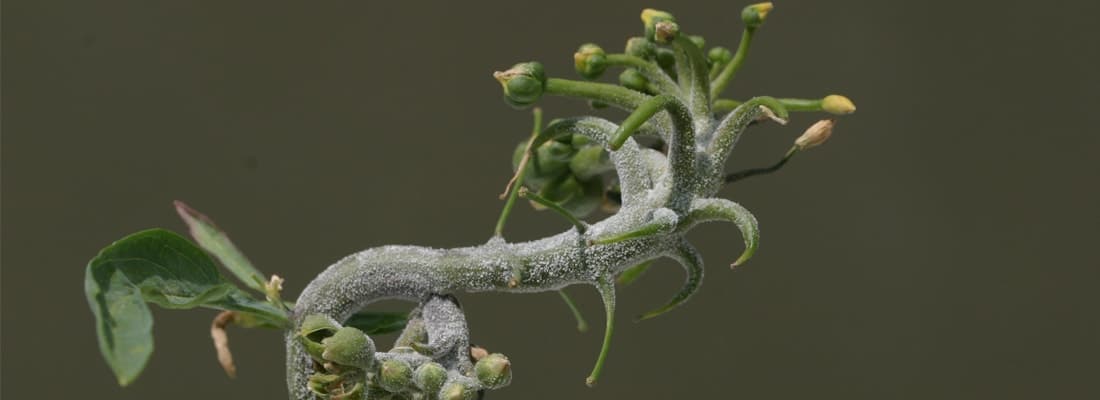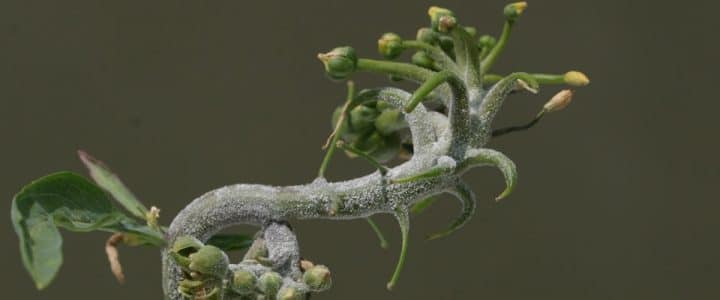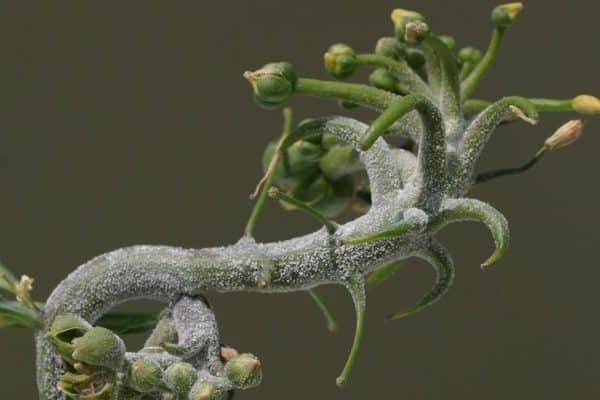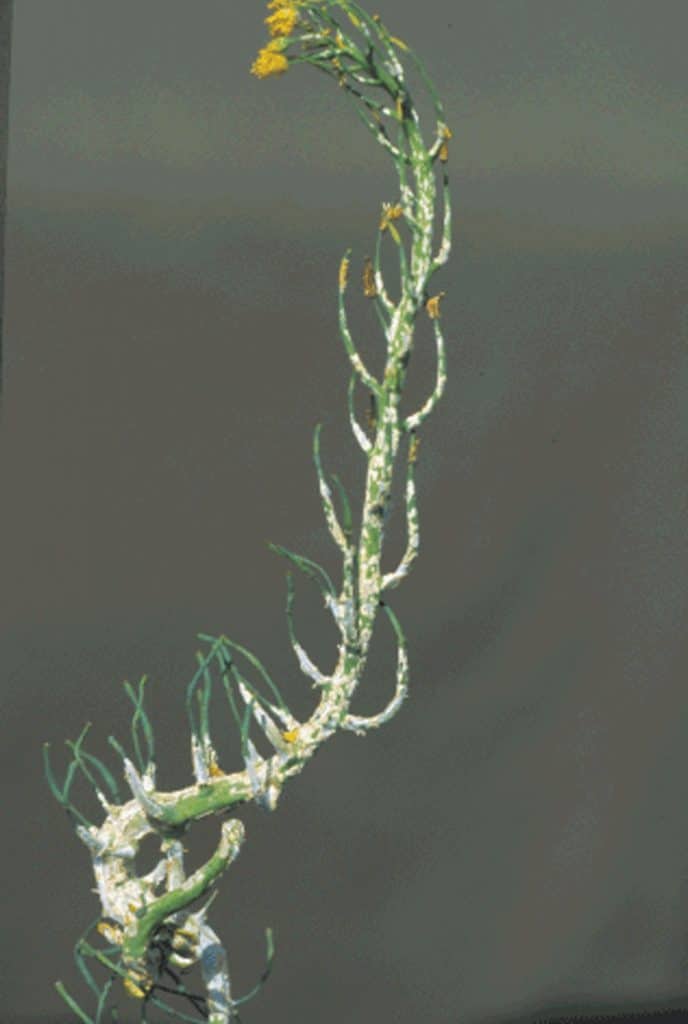White rust is a canola disease caused by the pathogenA disease-causing organism (such as a fungus or bacteria). More Albugo candida that affects mainly Brassica rapaAlso referred to as Polish canola, it is the less commonly grown species of canola currently grown in Canada. More and B. junceaAlso referred to as brown mustard, it is a minor crop (from the Cruciferae or Brassicaceae plant family, commonly known as the mustard family) grown in Canada. More cultivarsCultivars are variants in a species developed through the intervention of humans (despite the term 'variety' often being incorrectly used to describe this). Cultivars can be open-pollinated type, hybrid, synthetic, composite, etc. More. B. napusAlso referred to as Argentine canola, it is the species of canola currently commonly grown in Canada. More cultivarsCultivars are variants in a species developed through the intervention of humans (despite the term 'variety' often being incorrectly used to describe this). Cultivars can be open-pollinated type, hybrid, synthetic, composite, etc. More are resistant. This disease was a common problem for canola growers when B. rapaAlso referred to as Polish canola, it is the less commonly grown species of canola currently grown in Canada. More acres were high (many decades ago), but since B. napusAlso referred to as Argentine canola, it is the species of canola currently commonly grown in Canada. More cultivarsCultivars are variants in a species developed through the intervention of humans (despite the term 'variety' often being incorrectly used to describe this). Cultivars can be open-pollinated type, hybrid, synthetic, composite, etc. More currently make up the majority of canola acres in Western Canada, it is a minor disease.
Overview
The pathogen Albugo candida causes this plant disease. White rust (which is also sometimes referred to as staghead) is a common disease of Brassica rapaAlso referred to as Polish canola, it is the less commonly grown species of canola currently grown in Canada. More and B. junceaAlso referred to as brown mustard, it is a minor crop (from the Cruciferae or Brassicaceae plant family, commonly known as the mustard family) grown in Canada. More cultivarsCultivars are variants in a species developed through the intervention of humans (despite the term 'variety' often being incorrectly used to describe this). Cultivars can be open-pollinated type, hybrid, synthetic, composite, etc. More throughout western Canada. Some cultivarsCultivars are variants in a species developed through the intervention of humans (despite the term 'variety' often being incorrectly used to describe this). Cultivars can be open-pollinated type, hybrid, synthetic, composite, etc. More have resistance to one of the two races that have been identified from B. rapaAlso referred to as Polish canola, it is the less commonly grown species of canola currently grown in Canada. More, but are susceptible to the other. Efforts have been put towards developing cultivarsCultivars are variants in a species developed through the intervention of humans (despite the term 'variety' often being incorrectly used to describe this). Cultivars can be open-pollinated type, hybrid, synthetic, composite, etc. More with resistance to both races. CultivarsCultivars are variants in a species developed through the intervention of humans (despite the term 'variety' often being incorrectly used to describe this). Cultivars can be open-pollinated type, hybrid, synthetic, composite, etc. More of B. napusAlso referred to as Argentine canola, it is the species of canola currently commonly grown in Canada. More are resistant to the current races of A. candida. Yield losses in excess of 20 per cent have been recorded on susceptible B. rapaAlso referred to as Polish canola, it is the less commonly grown species of canola currently grown in Canada. More cultivarsCultivars are variants in a species developed through the intervention of humans (despite the term 'variety' often being incorrectly used to describe this). Cultivars can be open-pollinated type, hybrid, synthetic, composite, etc. More, when severely infected. White rust can cause disease problems on cruciferousPlants belonging to the family Brassicaceae or (previously referred to as) Cruciferae. More weeds. Races are generally fairly host or species specific (for example, white rust from the weed shepherd’s purse does not infect B. rapaAlso referred to as Polish canola, it is the less commonly grown species of canola currently grown in Canada. More and vice versa).
Symptoms
White to cream-coloured masses or pustules appear on the underside of leaves from the seedling stage onward. Following infection of the stems and pods, raised green blisters form that turn white during wet weather. The most conspicuous symptom is the presence of swollen, twisted and distorted inflorescences called “stagheads” that become brown, hard and dry as they mature.
Disease cycle
The pathogenA disease-causing organism (such as a fungus or bacteria). More overwinters as resting spores in decaying infected plant tissues (mainly stagheads) or as a seed contaminant. These spores may remain dormant in soil or on seed for a number of years. In the spring, some of the spores germinate and infect the cotyledons and leaves of young susceptible plants. These infections develop and white pustules are formed on the underside of leaves or on stems. The pustules release chalk-like, airborne spores that can spread the disease to other parts of the plant or to nearby plants to cause secondary infections on leaves, stems or flower buds. Stagheads develop from infected flower buds. At harvest, stagheads may be broken during threshing, resulting in physical contamination of the seed with resting spores.
Management
Grow resistant cultivarsCultivars are variants in a species developed through the intervention of humans (despite the term 'variety' often being incorrectly used to describe this). Cultivars can be open-pollinated type, hybrid, synthetic, composite, etc. More, use certified seed, and use a crop rotation with at least three years between canola crops.




